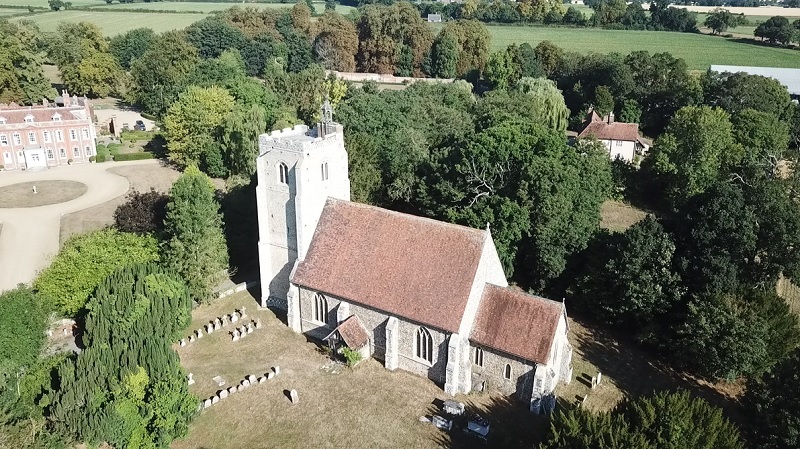Webmaster Notes
The patron of a church seems to be different now than it was in the past. Whereas it used to be that the land-owner or lord of the manor was the patron when money got a little tighter and there wasn't such a person in the parish as the manor house had been sold and/or was not associated directly with the parish, the patronage is unclear.
The travails of the Church of England have not helped this situation. Parishes without a formal patron are possibly the most common.
The current patron of St. Mary's Belchamp Walter is Charles Raymond of Belchamp Hall.
The role of a Patron of a church
When trying to understand the role of a "patron" of a church and how this relates to
Belchamp Walter, its history and the present
situation, I thought that I would try and see what the official position was.
The definition that can be found on the Church of England website is not much help in understanding what the situation is in the 21st century.
What the Church of England say about what a patron is:
Church patronage has a long history in the life of the church. Patronage is the right to put forward a person to take up a particular type of Clergy post: – to ‘present’ a person to Church of England benefice* (sometimes known as the ‘living’).
The candidate is then appointed (‘instituted’ to the benefice) by the Bishop. In London this is done by the Diocesan Bishop except where there is an Area Bishop (in accordance with arrangements set up under the London Area Scheme).
Technically, patronage is a property right which may be transferred, but not sold. The historic root of much patronage lay with the ownership of land and arrangements whereby the Bishop may place a priest at a place when housing and maintenance have been provided. The historic complexity of the legal position has been simplified by the Patronage (Benefices) Measure 1986.
Under the 1986 Measure, the Diocesan Registrar keeps a register of patrons - those with rights to present to benefices
– in practice these can be individuals, colleges, trusts, patronage societies (reflecting particular church backgrounds or theological positions), the Crown, the Diocesan Bishop, the Diocesan Board of Patronage itself, colleges, trusts and private individuals.
When a vacancy occurs, the appointment’s process established by the 1986 Measure involves a notice procedure and the drawing up a statement of the conditions, needs and tradition of the parish (at parish level) and of the needs of the diocese and the wider interests of the church (by the Bishop).
“*A benefice is the legal and corporate form of clergy post that carries with it responsibility for a parish or parishes (i.e. not an assistant post).” (Drawn from Mark Hill’s Ecclesiastical Law 1995)
The Diocesan Board of Patronage holds the right of patronage in relation to certain parishes in the Diocese, and meets to act as and when necessary.
The Board elects one of its members other than the bishop to be the chairman of the Board.
As I said - a historical term......
Top
From what I can detemine the current patron and those that are part of the PCC that are involved
with the church operations do not understand what a "patron" actually is. The term is largely historical
and does not really mean that much in the 21st century. A wealthy landowner may well have been the patron of
a church in previous centuries, but the realities of todays finances mean that this is not impossible. The cost
of up-keep of an estate that may well have been associated with a parish means that there is little left over
to support the church or the community in general.
The patron of Belchamp Walter - in 1583 it was St Edmund's Hall
The connection to Belchamp Walter and the de Veres could be that of Abingdon in Berkshire, Abingdon-on-Thames. The de Veres were first recorded as from Abingdon and the Priory of Earl's Colne was founded as dependant cell of Abingdon Abbey.
St Edmund's Hall was listed as the Patron in 1583. The fact that St Edmund's Hall took its name from St Edmund
of Abingdon seems to be too much of a coincidence. The attribution of the "ownership"
of the Church of St. Mary's to the Priory at Earl's Colne,
even up to the 20th century, is also a stretch.
St. Edmunds Hall say about their hall (not patronage):
The Hall takes its name from St Edmund of Abingdon, Archbishop of Canterbury (1234–40), who traditionally resided
and taught in a house at the western end of the present front quadrangle when he was a Regent Master in the Arts,
probably in the 1190s.
However, if Colne Priory was a dependant cell of Abingdon Abbey in 1583 the the patronage by
St. Edmunds of Abingdon makes sense.
It should be noted that this is a different St. Edmund, not the one that is depicted in the medieval wall painting in St. Mary's
1583 - the year that St. Edmunds Hall was the patron of St. Mary's
In 1583, Edward de Vere, 17th Earl of Oxford, was aged 43 and probably a courtier to Elizabeth I. He could also
have been writing some of the plays attributed to Shakespeare.
The de Veres were the founders of Colne Priory in Essex.
Abingdon Abbey (formally Abbey of Saint Mary) was a Benedictine monastery in Abingdon-on-Thames in the modern
county of Oxfordshire in the United Kingdom.[1] Situated near to the River Thames, it was founded in c.675 AD
and was dedicated to Mary, mother of Jesus.[2] It was disestablished in 1538 during the dissolution of the
monasteries.
A few physical remnants of the Abbey buildings survive within Abingdon-on-Thames.
